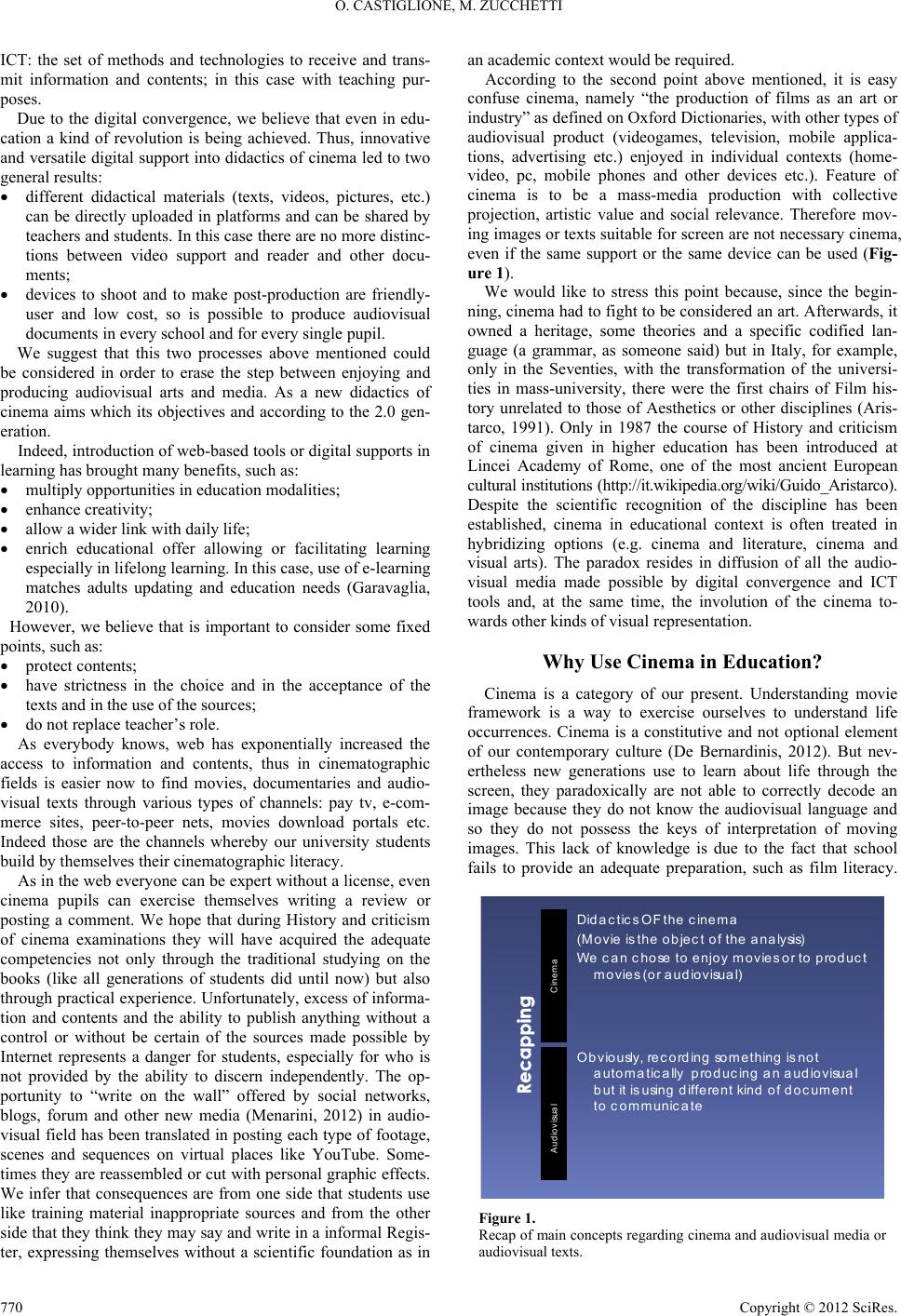
O. CASTIGLIONE, M. ZUCCHETTI
ICT: the set of methods and technologies to receive and trans-
mit information and contents; in this case with teaching pur-
poses.
Due to the digital convergence, we believe that even in edu-
cation a kind of revolution is being achieved. Thus, innovative
and versatile digital support into didactics of cinema led to two
general results:
different didactical materials (texts, videos, pictures, etc.)
can be directly uploaded in platforms and can be shared by
teachers and students. In this case there are no more distinc-
tions between video support and reader and other docu-
ments;
devices to shoot and to make post-production are friendly-
user and low cost, so is possible to produce audiovisual
documents in every school and for every single pupil.
We suggest that this two processes above mentioned could
be considered in order to erase the step between enjoying and
producing audiovisual arts and media. As a new didactics of
cinema aims which its objectives and according to the 2.0 gen-
eration.
Indeed, introduction of web-based tools or digital supports in
learning has brought many benefits, such as:
multiply opportunities in education modalities;
enhance creativi ty;
allow a wider link with daily life;
enrich educational offer allowing or facilitating learning
especially in lifelong learning. In this case, use of e-learning
matches adults updating and education needs (Garavaglia,
2010).
However, we believe that is important to consider some fixed
points, such as:
protect contents;
have strictness in the choice and in the acceptance of the
texts and in the use of the sources;
do not replace teacher’s role.
As everybody knows, web has exponentially increased the
access to information and contents, thus in cinematographic
fields is easier now to find movies, documentaries and audio-
visual texts through various types of channels: pay tv, e-com-
merce sites, peer-to-peer nets, movies download portals etc.
Indeed those are the channels whereby our university students
build by themselves their cinematographic literacy.
As in the web everyone can be expert without a license, even
cinema pupils can exercise themselves writing a review or
posting a comment. We hope that during History and criticism
of cinema examinations they will have acquired the adequate
competencies not only through the traditional studying on the
books (like all generations of students did until now) but also
through practical experience. Unfortunately, excess of informa-
tion and contents and the ability to publish anything without a
control or without be certain of the sources made possible by
Internet represents a danger for students, especially for who is
not provided by the ability to discern independently. The op-
portunity to “write on the wall” offered by social networks,
blogs, forum and other new media (Menarini, 2012) in audio-
visual field has been translated in posting each type of footage,
scenes and sequences on virtual places like YouTube. Some-
times they are reassembled or cut with personal graphic effects.
We infer that consequences are from one side that students use
like training material inappropriate sources and from the other
side that they think they may say and write in a informal Regis-
ter, expressing themselves without a scientific foundation as in
an academic context would be required.
According to the second point above mentioned, it is easy
confuse cinema, namely “the production of films as an art or
industry” as defined on Oxford Dictionaries, with other types of
audiovisual product (videogames, television, mobile applica-
tions, advertising etc.) enjoyed in individual contexts (home-
video, pc, mobile phones and other devices etc.). Feature of
cinema is to be a mass-media production with collective
projection, artistic value and social relevance. Therefore mov-
ing images or texts suitable for screen are not necessary cinema,
even if the same support or the same device can be used (Fig-
ure 1).
We would like to stress this point because, since the begin-
ning, cinema had to fight to be considered an art. Afterwards, it
owned a heritage, some theories and a specific codified lan-
guage (a grammar, as someone said) but in Italy, for example,
only in the Seventies, with the transformation of the universi-
ties in mass-university, there were the first chairs of Film his-
tory unrelated to those of Aesthetics or other disciplines (Aris-
tarco, 1991). Only in 1987 the course of History and criticism
of cinema given in higher education has been introduced at
Lincei Academy of Rome, one of the most ancient European
cultural institutio ns (http://it.wikipedia.org/ wiki/Guido_Aristarco).
Despite the scientific recognition of the discipline has been
established, cinema in educational context is often treated in
hybridizing options (e.g. cinema and literature, cinema and
visual arts). The paradox resides in diffusion of all the audio-
visual media made possible by digital convergence and ICT
tools and, at the same time, the involution of the cinema to-
wards other kinds of visual representation.
Why Use Cinema in Education?
Cinema is a category of our present. Understanding movie
framework is a way to exercise ourselves to understand life
occurrences. Cinema is a constitutive and not optional element
of our contemporary culture (De Bernardinis, 2012). But nev-
ertheless new generations use to learn about life through the
screen, they paradoxically are not able to correctly decode an
image because they do not know the audiovisual language and
so they do not possess the keys of interpretation of moving
images. This lack of knowledge is due to the fact that school
fails to provide an adequate preparation, such as film literacy.
CinemaAudiovisual
Didactics OF the cinema
(Movie is the object of the analysis)
We can chose to enjoymovies or to product
movies (or audiovisual)
Obviously, recording something is not
automatically producing an audiovisual
but it is using different kind of document
to communicate
Figure 1.
Recap of main concepts regarding cinema and audiovisual media or
audiovisual texts.
Copyright © 2012 SciRes.
770